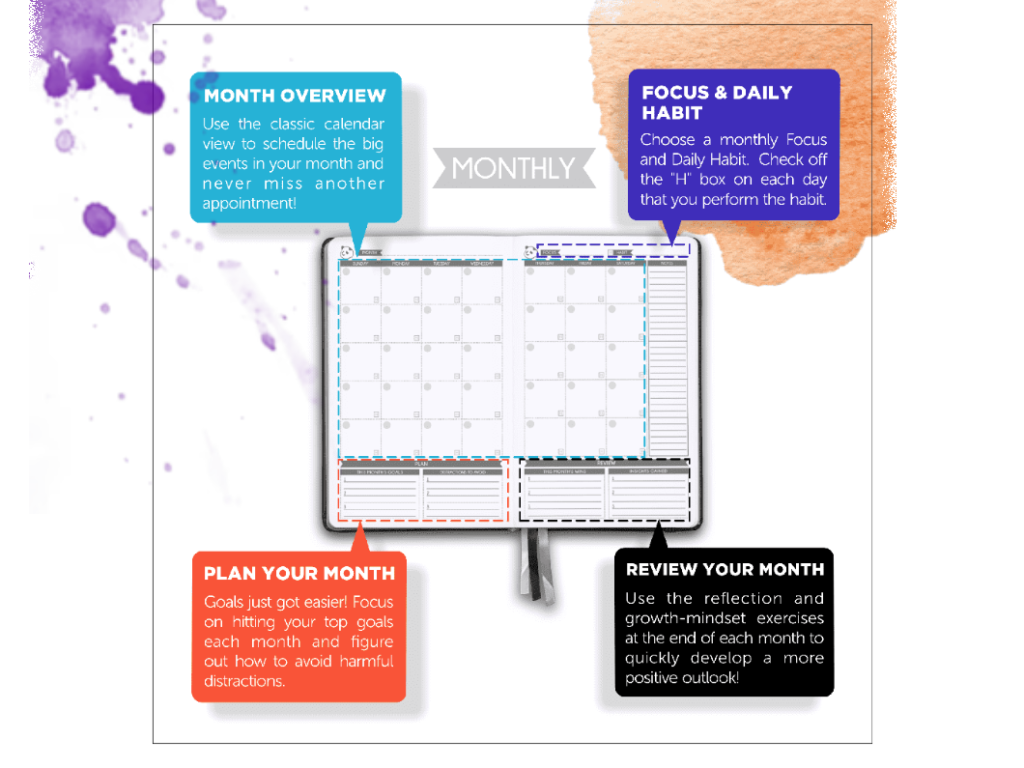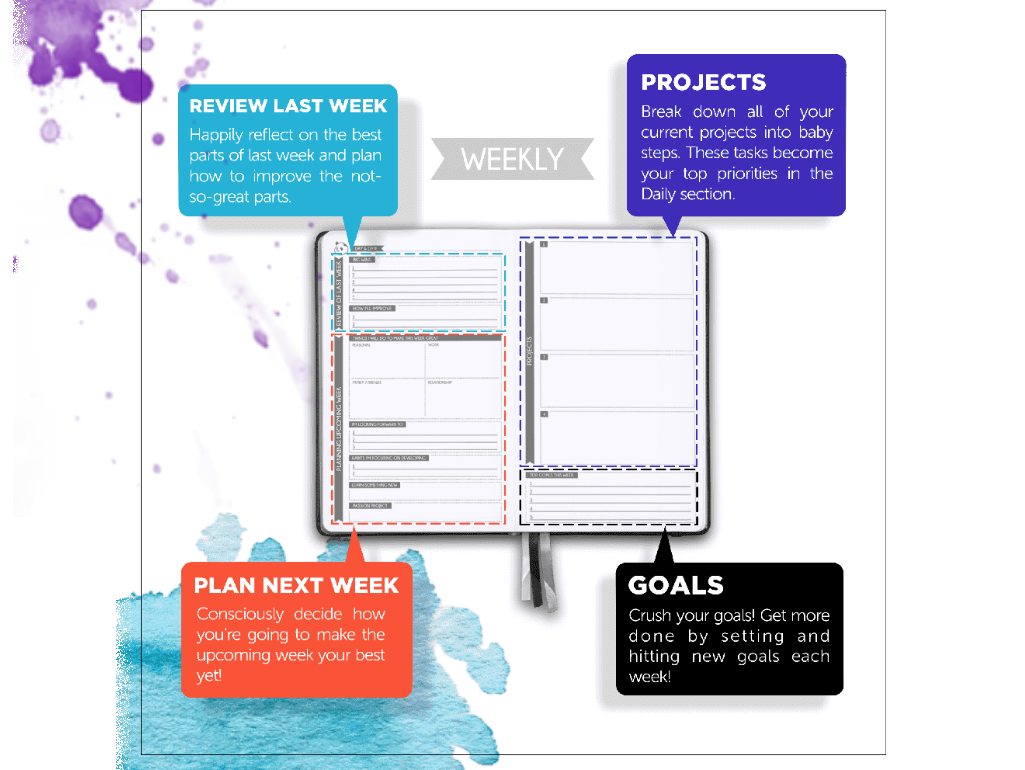Part 3 – Goals and Planning
Disclaimer: I try not to endorse products or companies on this blog unless I’ve got a really good reason. I have talked a lot about my Panda Planner [1] in this series, but that’s because it’s the product that I use, and all I can really do here is speak to my own experiences. I’m not familiar with other planners or productivity software, but I will say that I know people who use other products – or no products at all, simply adopting some of the behaviors described below without making a purchase. And, ultimately, that’s what I hope to focus on in this post: the approach, not the tool. As mentioned before, I previously used my Panda Planner in an unhelpful way, and I felt worse about myself in the process. I’m using it more effectively now, and I feel much better this time, but I could conceivably take the same steps with a blank notepad (in fact, I have a friend who does.)
We left off last week after building upon the essentialism of Marie Kondo [2] and Catherine Price [3] (identifying what your goal is and minimizing distractions that don’t support your work in achieving it) with implementation practices from Charles Duhigg [4] and James Clear [5] (building structures that enable you to work toward your goal and regularly reassess your priorities and tactics). In the wake of a recent conversation with a friend about how I actually achieve these steps myself, it made sense to continue this series with a look at converting theory to practice, providing examples of what I’ve been doing these past seven months, what has worked, and what hasn’t.
Using my planner has become a ritual for me at the beginning and end of each day, week, and month, which is a function of how the planner itself is set up. In describing the process of setting larger goals and breaking them down into smaller components, I cannot stress enough the importance of the theory described in parts 1 and 2 of this series. [6],[7] The idea here (what I failed to do when I first tried to use this planner in 2019, and what I am still trying to do successfully now) is starting by identifying your own priorities – not what you think you should be doing, but what will actually support an ideal end state you’re working toward. And ultimately, I will point out that even if you are only able to defend tiny windows of time for your priorities, that is enough of a critical step in the right direction – one that many people don’t currently take.

Image credit: [8]
Beginning of the Month
Being a visually oriented person, I really appreciate having a monthly calendar setup in the front of the planner. A physical paper-and-pen schedule in front of me still feels more immediate, organic, and – for lack of a better term – real than my electronic calendars. And since I have multiple calendars (work and personal), sometimes I don’t remember where scheduled events end up, especially when they don’t sync properly. In this physical calendar, I tend to make note of things I wouldn’t necessarily keep track of electronically, such as when to water the plants and feed the birds; upcoming blog post topics and menstrual cycles; random ideas, reminders, and store lists, all as they occur to me.
In addition to the calendar itself, there is room to set specific goals for things you want to accomplish over the course of the month. Ideally, I try to look at the goal-setting component before I look at the calendar and the wall of obligations it represents. (Note: in Cal Newport’s Digital Minimalism, [9] he talks about setting quarterly project goals and breaking them into smaller segments. The planner I use is designed for three months, and while it doesn’t specifically provide the structure for anything longer-term than monthly, that doesn’t mean you can’t do that yourself.) As a counterpoint to setting monthly goals, you also have the ability to identify potential pitfalls that will pull you away from productivity. My most commonly identified risk is falling into the digital rabbit hole of catching up on Facebook notifications, emails, and unwatched YouTube videos, “just for a few minutes.”
During the course of the month, you have the opportunity to focus on building certain habits and attitudes. Once you identify a new habit you want to build, you can put a check-mark in every day you’ve accomplished it. In previous months I have tried to focus on building habits that are good for me, things I “should” be doing (e.g. taking vitamins, drinking water throughout the day), and while those are important, I went with something in July that would really enrich my day and spark joy: taking time to read, even if just a few minutes before bed. I have noticed (and James Clear agrees) that there is no trick to making something a habit other than just continuing to do it. I used to think that once I did something 21 times (or whatever the magic number is), it would stick – it doesn’t. The only way to build a positive habit is by identifying your end goal and setting up systems that support it, even if it just means taking tiny actions that add up over time.

Image credit: [10]
The biggest challenge for me with using this planner is breaking out of the to-do list mindset. Instead of thinking of everything that needs to get done and listing it all, I have tried very hard to think about my priorities in a much more abstract way, focusing more on my values than on specific actions. It is best to start this process at a longer timeframe, such as monthly, so those priorities are built into the foundation of your smaller (weekly or daily) goals. Again, you can certainly make sure you’re doing this extra step on your own, but in the context of the planner I’m using, I feel like the monthly structure doesn’t lend itself to this kind of mental shift as much as the weekly structure does. From a psychological standpoint, I would say that the weekly setup really dives into the difference between commitment and attachment.
Beginning of the Week
To use a specific example of what I mean by commitment vs. attachment, I will point to my “Hindsight is 2020” [11] posts, which described how many of us still held ourselves to the standards of “normal” times in a year that was anything but. Instances of “attachment” are especially frequent during the holidays: many of us (women and mothers in particular) are attached to certain traditions of getting all the secret family recipe cookies baked, all the cards signed and mailed, and all the perfect presents bought and wrapped. In that frenzy of attachment to perfection – in hopes that everyone else has wonderful memories of the holiday – we often lose sleep, get stressed, and don’t have a wonderful holiday ourselves.
Alternatively, we could make a commitment to certain things, such as spending quality time with friends and family, as I described in a Christmas post the following year. [12] Upon talking to the people in your life, you may find that they’d rather sit down and watch a favorite holiday movie with you (ahem – Die Hard!) instead of having every single type of traditional cookie on the table. Making a commitment to, for example, quality time provides a more abstract goal that also allows for flexibility in what the specifics ultimately look like. And that is the shift I have been working to make when completing the much more detailed and thoughtful weekly section.

Image credit: [13]
The setup here does not start with having you list your goals for the week. Rather, it starts by very simply asking you to think about how you will make this week great for yourself and with respect to your family and friends, your job, and your relationship with someone else. As an example of how I committed to a certain type of behavior rather than a specific activity this week, instead of writing “prepare for team-wide meeting” under the work question, I wrote “continue to gather input from team to help people feel supported and empowered.” The meeting prep will get done because it needs to, but actively engaging my team for input before, during, and after that meeting will only happen if I make it a priority – and keeping that goal in mind may impact how I show up for that meeting.
It’s only after identifying things you’re looking forward to in the coming week, opportunities for building new habits, things you’d like to learn about, and specific projects to which you want to devote your attention, that you have the opportunity to set goals for your week. The specific goals should flow from everything you wrote before – what you’re trying to achieve, not the other way around. I still feel myself falling into the trap of generating a list of goals based on what I think I need to be doing, even after completing the prior exercises. In order to combat that, I will occasionally create goals that are simply a broader commitment to things I want to do: carving out time for gardening, reading, or a date night with Christian.
~
This post has gone far longer than I anticipated (as has this series), so we will conclude next week with details on applying this approach every morning, as well as evaluating the process – a critical but oft-overlooked step in increasing productivity.
Have you tried an approach like this one? What has worked or not worked for you? I’d love to hear about it below.
Thanks for reading!
[2] https://www.goodreads.com/book/show/22318578-the-life-changing-magic-of-tidying-up
[3] https://www.goodreads.com/book/show/35209767-how-to-break-up-with-your-phone
[4] https://www.goodreads.com/book/show/12609433-the-power-of-habit
[5] https://www.goodreads.com/book/show/40121378-atomic-habits
[6] https://radicalmoderate.online/the-greatest-productivity-hack-part-1/
[7] https://radicalmoderate.online/the-greatest-productivity-hack-part-2/
[8] https://www.nytimes.com/guides/business/how-to-improve-your-productivity-at-work
[9] https://www.goodreads.com/book/show/44160076-digital-minimalism
[10] https://pandaplanner.com/products/panda-planner-classic-original
[11] https://radicalmoderate.online/hindsight-is-2020-part-1/
[12] https://radicalmoderate.online/real-vs-plastic-christmas-trees-part-4/
[13] https://pandaplanner.com/products/panda-planner-classic-original
0 Comments